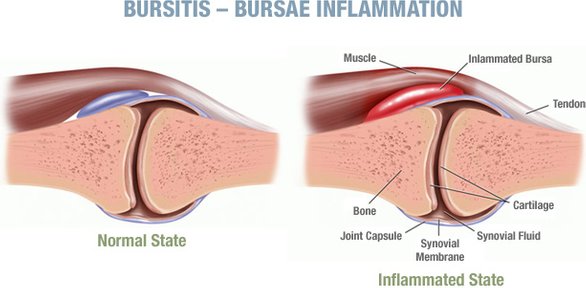BURSITIS
A bursa is a very thin, saclike, structure between e.g. tendons, ligaments, and bone and creates a smooth, almost frictionless functional gliding surface making normal movement painless.
“Bursitis” is defined as an inflammation of a bursa. Ultrasonography (echo) may be performed to identify bursitis and Magnetic resonance imaging (MRI) is also a very sensitive test for identification of bursitis. While bursa are present all over the body, the most common areas where inflammation or irritation occurs are at:
the hips,
the elbow,
the knee,
the shoulder.
The symptoms of bursitis may include: localized pain, swelling, warm feeling in or around the affected area, increased pain at night, pain worsened by movement, stiffness, reddening of the skin…
Injury (acute trauma), repeated pressure and overuse of a particular body part are common causes of bursitis. Examples of sports that can cause bursitis include hiking, cycling, jogging, jumping, tennis, squash…
When bursitis occurs, movement relying upon the inflamed bursa becomes difficult and painful and can be disabling.
Most bursitis patients respond to nonsurgical management, including ice, activity modification, and non-steroidal anti-inflammatory drugs. However, improvement of bursitis complaints after corticosteroid (cortisone) injection is reported to be temporarily only.
Patients frequently undergo multiple courses of nonoperative treatment, experiencing only temporary and incomplete pain relief. Surprisingly, there are relatively few high-level studies examining the efficacy of operative and nonoperative treatment of this often minimized yet troublesome condition.
Surgical removal, which is reserved as a last resort, is also not devoid of recurrence nor complications.

